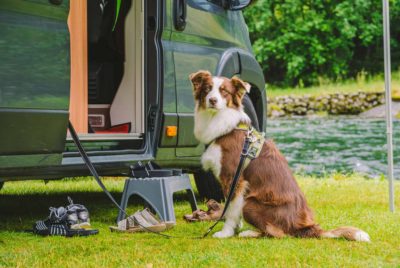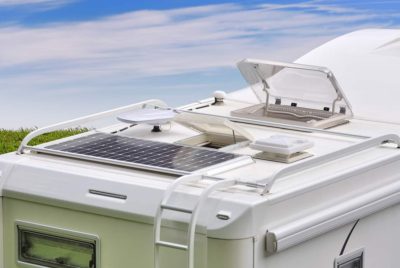We may earn a commission for purchases made using our links. See our disclosure to learn…
RV Water Heater Basics

We may earn a commission for purchases made using our links. See our disclosure to learn more.
One aspect of having the comfort of home when RVing is hot water. Being able to step into a nice warm shower in the privacy of your RV is why some choose an RV over tent camping. Understanding your RV water heater will keep your RVing experience feeling like a home away from home.
RV water heaters are similar to residential water heaters in how they function. One of the biggest differences is the size of the holding tank. While the water heater for a small residence might hold 40 gallons, the standard RV water heater is only 6 gallons. Some manufacturers offer an upgrade to a 10-gallon water heater.
The majority of modern rv water heaters operate on either electricity or liquid propane(LP) gas. The water heaters are controlled by a thermostat so the heater only runs as needed. The standard thermostat on an rv water heater is factory set, usually 140 degrees, and can’t be adjusted.
Typical RV Water Heaters
6-gal Manual LP(liquid propane) Gas
This basic LP water heater is usually only found in entry-level RVs. Much like a gas residential water heater, a valve must be set to “Pilot” position to light the pilot flame with a match or sparking device. The valve is then moved to the “Run” position for operation. Once the pilot is lit, the heater contact circuit board detects the flame. If the flame goes out the sensor stops the flow of propane.
6-gal LP Gas with DSI (direct spark ignition)
There is no pilot light with this system. DSI is a low voltage ignitor (12V DC power) that takes the place of the pilot light. It is both safer and uses less propane.
6-gal LP Gas with DSI/ Electric

Many modern RVs offer this dual-mode water heater. The electric mode can be used whenever you have 120V shore power or generator power. An electric RV water heater requires about 12 amps (1400 watts). If your RV only has 30amp shore power you have to take this into consideration when using other high-power appliances like the air conditioner or microwave at the same time.

There are separate on/off switches to operate the LP mode and the electric mode. This gives you the option to use either mode to heat your water which can take about 20 minutes. You can engage both modes at once for faster hot water. While there is no need to turn off water heaters when not in use, it is energy-saving to turn them off between uses.
Maintenance
Rv water heaters are relatively low maintenance. They should be drained at least once a year, every 6 months if used constantly. Flushing the tank with a water sprayer wand will help remove any sediment or rust and extend the tank’s lifespan. It is recommended that the tank be drained anytime the RV is stored for a long period of time.
The leading brands of RV water heaters are Atwood and Suburban. Atwood uses an aluminum holding tank while Suburban’s holding tank is steel. To drain the Atwood water heater you simply remove the plug. The Suburban’s plug is actually an anode rod to slow corrosion of the steel tank. The rod attracts corrosive effects to itself through electrolysis. If the rod is more than half corroded it should be replaced.
It is advisable to have a spare water heater plug or anode rod, depending on which brand of RV water heater you have, on hand when you perform the maintenance.
The burner tube of gas-fired heaters should also be checked during the routine inspection of your water heater. Insects, especially mud daubers like the water heater area for building nests. Remove rust and any other potential obstructions.
Winterizing
Most modern water heaters have a bypass valve which will divert water away from the water heater while allowing it to flow through the rest of the system. Where freezing temperatures occur, it is recommended to toggle the bypass valve before the first freeze. It is important to toggle the bypass back to allow water flow back to the tank when you are ready to use it again. Turning a water heater on when the tank does not have water in it will burn a heating element out.
Lukewarm water problem
If you are only getting lukewarm water check that all hot and cold faucets are closed, including those to outside shower or other water lines. Sometimes the shower sprayer is toggled off but the faucets are not turned off which allows the hot and cold water to mingle.
Less Common RV Water Heater Options
16-Gallon water heater
A 16-gallon water heater is actually a 10-gallon tank of superheated water that then mixes in cold water at the outlet, providing roughly the equivalent of a 16-gallons of hot water at 140 degrees.
Tankless water heater
Tankless water heaters are trouted as having “endless” hot water on supply. The first tankless unit on the market was manufactured by Girard in 2009. They have no “holding” tank so take less space than traditional water tanks. There is also no recovery time and they are energy efficient.
Tankless water heaters are more expensive than traditional water heaters and more complex. Customer comments suggest to get expected hot water delivery there must be adequate water pressure and the temperature needs to be reduced or the output hot water is not constant temperature.
Motoraid
Motoraid is not a type of water heater but rather a method of heating the water utilized by some motorhomes. The fluid is circulated through tubes embedded in the water heater from the engine’s cooling system. It only comes into play when the engine is running.



